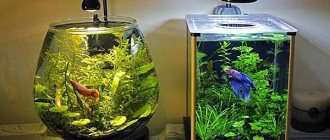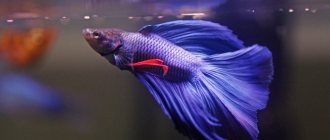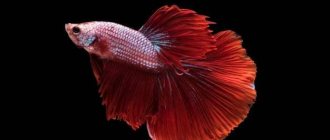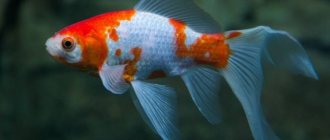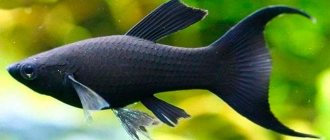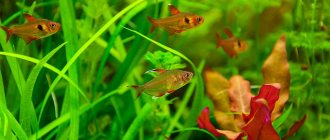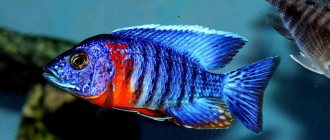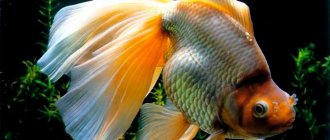Betta fish are beautiful but warlike members of the perciforme order from Southeast Asia.
They are widespread throughout Thailand. Until 1939, the state of Siam was located on the territory of what is now Thailand. This is where one of the names of the fish came from - the Siamese cockerel.
This aquarium fish is also called chicken fish, betta fish, and betta fish. The latter nickname appeared due to the cocky nature and aggressive behavior of the males.
Interesting: The warlike cockerel fish is capable of starting to fight even with its own reflection. There are known cases when, during such clashes with itself, the cockerel inflicted serious injuries.
Breeding Siamese cockerels is a complex process that takes place in 4 stages:
- Choosing a partner.
- Preparing for spawning.
- Spawning.
- Caring for the fry.
Female and male: differences
You can visually identify a male or female from the age of three months. There are several signs that distinguish a female betta fish from a male:
- Female betta fish are slightly smaller in size than males.
- The male individual is distinguished by a luxurious tail, and long fins, reminiscent of sails, with a brighter color in comparison with the fins of chickens.
Interesting: If a female cockerel was under stress, for example due to a change in environment, her color may become as bright as that of a male. In this case, it is almost impossible to determine the gender of the fish.
- The female , as a rule, is calmer than the self-confident and aggressive male.
Important! During the spawning period, the male betta fish becomes more hostile to its direct competitors and to fish of other species. To avoid collisions and fights, it is necessary to create hiding places in the aquarium.
- On the belly of the female there is a small white formation similar to an egg.
Yellow cockerel
Beautiful cockerel fish
Cockerel , or fighting fish, Siamese cockerel ( lat. Betta splendens) is a small labyrinthine fish of the Macropod family (Osphronemidae) .
This fish is widespread in small, warm, slow-flowing fresh water bodies of Southeast Asia, Thailand, Vietnam, the Malay Peninsula and the islands of Indonesia.
The cockerel has an elongated, oval, slightly laterally compressed body up to 4 cm (females) and up to 5 cm (males). However, in terms of brightness and beauty of color, they have no equal. Red, blue, yellow, green, pink colors, with every turn in good lighting the colors play, taking on different shades. Males become especially bright during spawning or a skirmish with other males. Female bettas are somewhat paler in color than males and have small fins. Although recently females have appeared with somewhat elongated fins, which are not inferior in color to males. Darker stripes run along or across the cockerel’s body, depending on its mood. The tail and upper fin are rounded, the lower one starts from the head and reaches the base of the tail, the pectoral fins of the fish are pointed. Scales are cycloid. In an excited state, the gill covers of males swell and protrude in the form of a collar.
The betta is a labyrinthine fish that requires unhindered access to atmospheric air to breathe.
Numerous color and veil variations have gained wide popularity in aquarium fish farming. If there is only one pair in the aquarium - a male and a female - then in normal times they have a dull color with a shade of the main color - red, blue, green or pink with brown oblong stripes running along the body from head to tail, and only during During spawning, both are painted in bright colors.
Determining the sex of bettas in comparison with other aquarium fish is a fairly easy task. The male betta fish is slimmer and brighter in color, and has longer fins. Female bettas are often smaller and have short fins. The main distinguishing feature of the female is the presence on the abdomen of a small “white speck” near the anus, which can be distinguished at about 3 months of age. This formation looks like an egg coming out.
In their homeland, fish are kept and bred only for sporting interest. There, no one is interested in the colors of the fish, but only in their fights. Special trainers prepare fish for fights, and competitions take place in the presence of a huge number of spectators. Betta fish have their own champions. Often, confrontations end in the death of one of the participants.
Origin of cockerels
Types of bettas
Matching
The appearance and beauty of the future offspring depend on the correct selection of a pair of betta fish. There are several recommendations:
- Pairs of the same breed are used for breeding.
- To ensure that the color of the new generation of bettas is uniform , you should choose fish of the same color.
- The female and male should be similar in size.
- When choosing a pair for breeding, you need to take into account that the age of both fish is in the range from 5 months (considered sexually mature) to one and a half years. The older the betta fish gets, the higher the likelihood of problems occurring during breeding - possible birth defects in the fry.
Important! It is better to buy betta fish for breeding from professional breeders rather than in pet stores. Since in the second case there is a chance to acquire a fish unsuitable for reproduction.
- Before crossing, you need to make sure that the pair is healthy. To do this, you should pay attention to the presence of the following signs: cloudy eyes; incompleteness of fins; presence of wounds on the body; decreased overall activity; poor appetite; faded color of scales. The detection of one or more signs should alert the owner and serve as a signal to contact a veterinarian.
- A couple that has been selected for breeding must get to know and get used to each other. Due to the fact that males sometimes behave quite aggressively, the introduction procedure is carried out by placing the fish in an aquarium with a transparent partition installed in the middle. Ideally, it is better to place a cockerel in an aquarium with a hen, since in its own territory, it will feel like a full-fledged owner, and in an unfamiliar environment it will become a little more peaceful.
Important! If both fish have the same defect, for example, uneven scales, there is a very high probability that the same feature will appear in the fry.
Signs of successful dating
There is no guarantee that the first, even carefully selected, beautiful pair of betta fish will like each other. There are several behavioral signs that are easy to notice if the dating stage is successful:
- Attempts to attract the attention of the female by demonstrating the beauty of bright fins and a long tail.
- Excited, but not aggressive behavior on the part of the male.
If within a few days the couple does not show mutual interest in each other, you should try to choose another female for the cockerel.
Red and blue cockerel
Cockerel fish: how to distinguish a female from a male
The body of the fish has the shape of a slightly elongated oval, slightly compressed at the sides.
Males reach 5 cm in length, females, of course, lag behind them and grow to a maximum of 4 cm. The cockerel is an amazing fish, fabulous in color. Their scales, perhaps, have no equal in the depth and brightness of colors. At the slightest movement of the cockerel, the blue, red, pink, green, yellow and orange colors of its body “break”, playing in the light with fantastic shades. Angry males acquire a special color when they sort things out. During the spawning period, the color of the betta also becomes deeper. Females are slightly inferior to gentlemen in the brightness of colors, and their fins are not so chic. True, when breeders came close to this issue, female cockerels acquired long fins and became almost as bright as the males.
The transverse and longitudinal parts of the cockerel's body are marked with dark stripes. The upper fin and tail of the fish are neatly rounded, and the lower fin is very long - from head to tail. The fins on the chest end with sharp edges. When the cockerel is very excited, it inflates its gills like a protruding collar framing its head.
Understanding where the cockerel is and where the “hen” is will not be difficult even for a novice aquarist. Males are naturally more graceful and colorful, and have more “sweeping” fins. Females are small, with not very long fins. However, this is not the main difference between the individuals. You can unmistakably identify a female by the presence of a small white speck in her anus.
Those for whom breeding cockerels as a means of earning money or as a kind of hobby need to know how to determine the sex and distinguish a male from a female. This is not difficult to do, since there are a number of differences between them, which can be noticed when the fry of betta fish have reached the age of 3 months.
Under normal conditions of existence, males of this species look much “more elegant” and brighter than females. However, if females, for one reason or another, experience stress associated with moving or human intervention, the intensity of their color may change and not be inferior in brightness to the color of the male, and then it will not be possible to determine the sex based on this characteristic.
Breeding cockerels
Breeders who have bettas need to know that the reproduction of these aquarium fish is possible if certain conditions are created for them. This process contains the following steps:
- Pair selection.
- Preparing for spawning.
- Betta fish spawning.
- Caring for the fry.
In order for the fish to begin spawning and reproduce successfully, it is necessary to approach each stage responsibly.
Pair selection
For reproduction, it is important to choose the right pair for the fish. Cockerels aged 5-6 months, but not older than one and a half years, are best suited for these purposes. The fact is that individuals who have lived more than 16-18 months often have problems with reproductive abilities. In such cases, betta fish fry are born with defects and the mortality rate is high.
If there is only one betta fish in the aquarium, but further reproduction is planned, a pair will need to be purchased from a breeder with a good reputation. It is not worth purchasing a male or female in a pet store, since sellers may not have information about the exact age or may deliberately mislead the buyer.
Betta fish spawn and reproduce without any problems if certain conditions are created for them. First of all, you will need to equip a spawning aquarium, which must meet the following requirements:
- have sufficient capacity and hold 40–50 liters of water;
- have a partition to create two places in the tank, for a male and a female;
- be suitable for placing aquarium shelters and planting floating plants.
To create favorable conditions for the fish, you will need to equip the spawning tank with a sponge filter and a heating device. For the fish to feel comfortable, the water temperature should be 27-28 degrees. It is not recommended to pour a lot of water into the tank; it is enough to fill it to 12-15 cm and place it in a quiet place.
In addition to aquarium equipment, successful breeding also requires proper feeding of the bettas. 14 days before the start of spawning, they should receive “live” food such as:
- worms;
- crickets;
- cockroaches;
- bloodworm;
- Artemia.
Before consuming insects, you will need to chop them up and feed the fish in such quantities that they are able to eat in order to avoid clogging the aquatic environment.
It is important to pay attention to the behavior of the bettas. A sign that individuals are showing interest in each other is considered to be an excited state and a demonstration of their own appearance when they straighten their fins and gill covers. But if the fish are aggressive, you will need to choose another pair for the female and male.
Spawning
Since cockerels are fish with a character that can show aggression towards their fellows, the spawning process looks unusual. First, the male builds a nest of air bubbles. To do this, it swallows oxygen and then spits it out, resulting in a lump of foam. The eggs of betta fish are stored here and the fry are kept until a certain time.
Before the start of spawning, the male individual behaves aggressively towards the partner, striking her. Then changes occur in the ritual dance when the pregnant female shows her partner imaginary eggs on her stomach, which provokes a new attack. The male wraps himself around his partner, putting pressure on the abdomen, which causes the release of eggs and milk.
Watch a video about preparing fish for spawning.
Caring for fry
Cockerel fry are not known for their survival rate, and therefore the care and maintenance of the fry requires a special approach. First of all, you will need to take care of the food in advance, which must be prepared 1-2 weeks before the appearance of the fry. The following is used as feed:
- ciliates;
- vinegar eel
- Artemia.
After 10-14 days, a microworm and finely chopped tubifex are added to the diet of the young animals. In addition to proper nutrition, it is necessary to take care of the comfortable conditions for keeping the young animals. This requires:
- Equip the aquarium with a compressor, since the respiratory organ is finally formed in fish only at the age of 20-22 days.
- Gradually reduce the temperature of the aquatic environment to 22-24 degrees.
- Replace 4/5 of the water volume daily.
- After 3 weeks, transfer the fry to a spacious vessel with a volume of 100 liters.
When the fry reach the age of 3 months, their sex can be determined with accuracy. And after six months the fish are already capable of reproduction.
If you follow the above rules and recommendations, breeding cockerels at home will not cause any difficulties even for a novice aquarist.
Watch a video about breeding cockerels.
There are quite a lot of them. The first thing to consider is age. Life expectancy for this species is limited to 3 years. In this case, puberty occurs already at 3-4 months. From this time on, the females can already discern eggs in their stomachs, and after 2 weeks they are ready to lay them. Many species, once ready to spawn, acquire noticeable stripes along the body. Typically, pet stores sell fish at this age.
The male cockerel is not only beautifully colored, but has wide fins - lateral, anal and caudal. In the official classification, it is customary to distinguish between varieties: long-tailed, short-tailed, crown-tailed, veiled-tailed and others. The difference between them is visible to the naked eye. The first one is the most spectacular. Aquarists achieve by crossing the unusual combinations of shapes and colors of this fighting species.
An excited and aggressive cockerel is a stunning sight. The fins floating in the water take up as much or even more space around him than his body. The female is much more modest in color and size; her fins do not have such a decorative function. But the main difference is considered to be a small growth on her belly (ovipositor), similar to a white egg; the male has nothing similar.
You can visually identify a male or female from the age of three months. There are several signs that distinguish a female betta fish from a male:
- Female betta fish are slightly smaller in size than males.
- The male individual is distinguished by a luxurious tail, and long fins, reminiscent of sails, with a brighter color in comparison with the fins of chickens.
Interesting: If a female cockerel was under stress, for example due to a change in environment, her color may become as bright as that of a male. In this case, it is almost impossible to determine the gender of the fish.
- The female, as a rule, is calmer than the self-confident and aggressive male.
We suggest you read: How to stop a cat from pooping in the litter box
Important! During the spawning period, the male betta fish becomes more hostile to its direct competitors and to fish of other species. To avoid collisions and fights, it is necessary to create hiding places in the aquarium.
- On the belly of the female there is a small white formation similar to an egg.
Yellow cockerel
External differences in cockerel fish begin to appear only at four months of age. Males begin to grow longer fins and a tail. Differences in size also become noticeable: males become larger and more massive. But in some short-tailed species (for example, poster bettas), it is difficult to navigate by the size of the fins. There is one external difference that is noticeable even in young fish.
In the photo, how to distinguish male and female betta fish is clearly visible: the pelvic fin of the male is always thin and long, while in the female it is wider and round. Females also have a more rounded abdomen and often have a distinct white dot visible on their belly. Although young males may also have a white dot on their abdomen before reaching maturity.
Preparing for spawning
Breeding betta fish at home is not difficult and can be done by a beginner in the aquarium business. However, for a successful outcome of the event, the aquarium owner will need to comply with certain conditions:
- For spawning, a special aquarium with a volume of 15 to 40 liters and a height of at least 15 cm is prepared.
- A partition is installed inside such an aquarium so that the male and female can be separated.
- Care should be taken to arrange places where the female can hide from the temperamental cockerel while the partition is removed.
Important! You can determine the time for spawning by the appearance of the female - the abdomen is noticeably rounded.
- It is necessary to provide a sponge filter and a water heating system in the sedimentation tank.
- In the spawning tank, the temperature is maintained in the range from 26 to 28° and the water acidity level is from 6 to 7.5 pH.
- 1.5 - 2 weeks before the start of spawning, live food is added to the daily diet of the female and male . It is preferable to feed bloodworms.
Aquarium fish Cockerel care and maintenance
A cockerel in an aquarium, being alone, is inactive; if there is no rival, then there is no need to fuss too much. A comfortable aquarium for one cockerel will be a volume of 3 liters or more, and for a couple from 5 liters, but a cockerel can live literally in a half-liter container. The soil can be fine sand or soil.
Due to the breathing characteristics of the Cockerel, the aquarium does not need to be equipped with an aeration system, and heating will not be superfluous. You can use artificial plants for decoration. In the case of aquarium plants in an aquarium, you need to be very careful - due to the small volume and lack of aeration, the water will quickly deteriorate. In such an aquarium, change and clean the surfaces of the aquarium at least once a week.
In the case of a complete water change, the inhabitant is placed in a separate container, and the soil and decorations are washed. Settled and prepared fresh water (not bottled!) should be at the same temperature as the fish.
Typically it ranges from 24-28° C, acidity from 6-8 pH, hardness from 5-15° dH. And you definitely need to leave a “gap” between the surface of the water and the lid - after all, these fish breathe air. Without such a gap, the cockerels will suffocate. A lid is necessary otherwise the bettas may jump out.
If all maintenance rules are followed, the life expectancy of a betta fish is up to 3 years.
Reproduction of cockerels
Many eyewitnesses compare the very process of breeding cockerels in an aquarium to some kind of unusual dance.
The cockerel, as a rule, behaves quite aggressively towards the female. Until the moment when the fish begins to spawn, the male chases it around the aquarium for some time and periodically strikes it. These actions of the cockerel allow him to achieve the level of arousal that is necessary for procreation.
Cockerel in a small aquarium
Interesting: Watching how betta fish reproduce, it can be noted that the hen does not stand sideways to the temperamental partner, because in this case it is easy to get injured.
The behavior of the male and female changes at the moment when the chicken fish shows the cockerel a light dot on its belly, similar to an egg. After this action, the next stage of the breeding process begins - hugging.
The male beats the female. By pressing on her stomach, he provokes the release of milk and white eggs into the water. Such hugs can be repeated several times. It is interesting to watch how the cockerel quickly and deftly picks up the eggs and carries them to the nest. The activity and speed of the male contrasts sharply with the immobility of the female herself, who remains in such a frozen state until the end of spawning.
Interesting: On average, after successful spawning, males may produce about 500 eggs.
After all the eggs have been transferred to the nest, it is recommended to place the tired female in another container or place a partition in the aquarium, since an energetic male can harm the female.
Next comes the incubation period. At this time, the small bubbles that make up the nest begin to burst. The task of the newly minted father of the family is to “repair” damaged areas in a timely manner and return the eggs that have fallen from the nest to their place. The duration of this period, as a rule, does not exceed 5-6 days.
Its completion and transition to the next stage will be marked by the appearance of larvae. At this point, the best solution would be to place the male in another aquarium so that he does not harm the fry.
Breeding
The breeding season is the only time when males and females can be kept together.
In order to encourage fish to reproduce, you will have to create ideal conditions for them. The water should be warm - about 26 ° C, and meals should be frequent and nutritious - 3-4 times a day in tiny portions.
If a couple is interested in each other, the female will darken and the male will begin to build a nest of bubbles. If he is aggressive towards his “chicken”, then you should put her in another container and wait until the cockerel completes the nest.
This type of fish can be quite capricious, and if the fish don’t have the same personalities, there’s nothing you can do about it, you’ll have to find another pair.
As soon as the nest is completed, the male becomes kinder towards the female and allows her to explore its structure. If the “hen” is satisfied, she allows the male to wrap himself around her. In this tender embrace, she releases portions of eggs, which are fertilized by the male. Both parents collect the eggs and place them in the air nest.
After spawning, the female is removed because the male becomes even more aggressive towards her and can even kill her. In addition, the female does not experience parental feelings for the offspring and may even eat the eggs.
The male will care for the offspring until they swim. Incubation of eggs lasts 2-3 days. Throughout this entire time, the male will pick up fallen eggs and remove the dead ones.
Often at night, when the cockerel cannot see or is sleeping, the eggs fall to the bottom and die. To prevent this, it is necessary to place a small lamp above the nest so that the male does not sleep at night and cares for the eggs.
As soon as the fry begin to swim, the water level in the aquarium is lowered, and the male is removed, since his parental instinct disappears quite quickly after this event.
The fry are fed “live dust” several times a day in small portions. The main thing is that the juveniles completely eat the food and there is no excess of it.
What to do next?
In order for the fry of these fighting fish to grow and become excellent representatives of their breed, care must be taken to create comfortable conditions for their development.
Recommendations for caring for betta fish at home:
- Feeding. Food for the fry should be prepared before they appear. In the first days, the menu welcomes the presence of brine shrimp, vinegar eels and ciliates. After a couple of weeks, tubifex is added to the daily diet, which is cut as finely as possible before feeding.
- Aquarium. The container in which it is planned to keep the fry must be equipped with a compressor. It is recommended to maintain the water temperature in the range from 22 to 24°. Since the temperature in the spawning area was 4-5° higher, then after the fry move to a new place, the temperature should drop gradually. It is necessary to refresh the water every day, replacing ¾ of the liquid of the total volume. 4-week-old fry are transplanted into a spacious aquarium.
- Life in a new aquarium. Until the moment when a small cockerel turns into a worthy representative of its breed, it can arouse increased interest among larger fish as food. Therefore, it is not recommended to transplant young specimens into an aquarium with pugnacious, overly active and predatory fish neighbors.
Keeping betta fish in captivity
Breeding experience shows that it is impossible to place several males in one aquarium at once. Females can be kept in schools, but separately from the male. A good choice is a male-female pair. Theoretically, if the aquarium capacity is more than 10 liters, then two males can divide this territory between themselves. However, this is rarely done, since in large containers the fins can become deformed and the fish will lose its decorative effect. This is explained by the fact that in its natural habitat, it settles in shallow rivers.
The range of comfortable water temperatures ranges from 18 to 24 degrees. However, at home it is recommended to maintain it at about 22-23 degrees. pH level ranges from 6.7 to 7.3. This mode is optimal for active life and reproduction. The capacity of the aquarium is selected at the rate of 3-4 liters for each individual.
Betta fish are a lungfish species, so they do not require artificial aeration. They are much more demanding about the purity of water and the environment. The recommended frequency of water changes is 2-3 weeks, since the accumulation of sludge at the bottom is unacceptable for these cleaners. Algae must grow at the bottom. Lighting is selected according to the choice of plants.
Cockerels can rightfully be called the most unpretentious aquarium inhabitants, even among labyrinth fish. Caring for them will not cause any trouble even for a completely inexperienced aquarist.
However, this does not mean that there is no need to create suitable conditions for them. Many sellers in pet stores assure customers that a betta fish can live even in a small plastic cup. Maybe, but not for long...
Like any fish, a betta must be able to swim to live. The minimum volume of an aquarium for keeping one betta is no less than five liters. And watching only one fish will be uninteresting even for a child.
Despite the myths about the convenience of round aquariums, low, no higher than 50 cm, rectangular containers are more suitable for bettas. It is advisable that the aquarium be planted and have several shelters where frightened inhabitants can hide.
If you plan to place several betta fish in the aquarium, it is better to choose one (maximum two) males and several females. It is better to buy fish very young; growing up together in the same aquarium, they will be more tolerant of each other. In young cockerels, external differences between the sexes are not yet very pronounced. Observing the behavior of juveniles will help you understand how to distinguish a female from a male in a betta fish.
Breeding aquarium bettas is not at all difficult; sometimes replacing the water with fresh water or a slight change in temperature is enough to stimulate spawning.
When breeding betta fish, the differences between the female and the male are more than noticeable. Surprisingly, females play a minor role.
The male himself builds a nest of air bubbles on the surface of the water, holding it together with saliva for strength. Small plants that float on the surface (such as duckweed or riccia) can be added to the breeding aquarium to provide the male with additional material for building a nest.
When the nest is ready, a female with eggs is placed next to the male (whether the female has eggs can be determined by the enlarged round abdomen).
After the end of spawning, the female must be removed from the spawning aquarium as quickly as possible; the male will perceive her as a threat to the offspring and constantly attack.
The male takes care of the eggs in the foam nest, and if everything went well, in a couple of days the tiny fry will begin to swim. Then you need to remove the male as well, because he may well mistake his offspring for food.
It is best to feed the fry with small live food, then they will grow quickly and be healthy.
A novice aquarist may have a question: why keep these quarrelsome, cocky cockerels? They can fight among themselves, offend other fish and jump out of the aquarium...
Despite its slightly problematic behavior, the betta is one of the most popular fish in home aquariums. Their aggressive behavior can be corrected by choosing the right neighbors and providing the fish with the necessary shelters.
And the fantastic beauty of aquarium cockerels, the richest range of colors and absolute unpretentiousness to living conditions rightfully make them the favorites of many aquarists.
Differences in structure
The unusual appearance, bright color and lively character of these aquarium fish attracts many. Perhaps these are the most popular aquarium fish that do not leave anyone indifferent. Many people believe that only professionals can distinguish a female from a male. But in fact, even a novice aquarist can easily cope with this. The main thing is to know exactly what their differences and features are.
If you look closely, you can see that the male looks a little different than the female . Betta fish differ in their structure, size, behavior and more. To begin with, you should pay attention to the structure of the pet. Pay attention to the length of the fins. In male cockerels they are much longer. The female betta fish has shorter fins. In addition, boys have larger fins and somewhat resemble sails. In adults, after about 6 months, they become even larger, wavy and beautiful.
Breeding at home
Cockerels reproduce easily and quickly. To do this, it is best to plant the couple in a small aquarium, with a volume of up to 5 liters and a length of at least 15 cm. It should have vegetation and no soil. Be sure to place aeration and decoration in which the female can hide from the male.
How to distinguish a female from a male
Female bettas do not have beautiful large fins and tails like males.
It is quite easy to distinguish a male from a female. The male is much larger, his body is bright with very long fins (sometimes they are even multi-colored). The amazing ability of the male is that before spawning or during a fight with an opponent, his color becomes brighter and more saturated.
The female is smaller than the male, its length reaches 4 cm. Dark stripes are clearly visible along the entire body, which are practically absent in males.
Mating and Spawning
In the case when the living conditions completely satisfy the betta fish, it prepares for spawning. You can find out about this not only by the color of the male, but also due to the fact that a large number of bubbles appear on the surface of the aquarium.
Bubbles are formed when the male rises to the surface of the water, swallows air, passes it through himself, adding his specific enzyme, and releases it back - this is how a real nest is formed. When it is completely ready, the male begins to chase the female.
During the spawning process, each egg enters its own air bubble, protecting it from various bacteria and damage.
During spawning, the male shows unprecedented care for his offspring. If the fry accidentally falls out of the bubble, the male will definitely pick it up and put it back.
How to find out by body size?
You can tell that it is a male betta fish in front of you by the size of its body. Males tend to be slimmer and larger. In the area of the tail, the boys' body narrows slightly, but in the area of the head, on the contrary, it thickens. In addition, their body is more flexible, and this is immediately visible during the active movement of the fish in the aquarium.
Females have a denser body, one might say, stocky. In addition, in female cockerels it is distinguished by relief. If you look closely, you can see a slight curve on the front of her abdomen.
Determining gender by behavioral characteristics
The betta fish is an active and even aggressive species of aquarium fish. This type of fish is considered a fighting fish, and real fights can often be observed in the aquarium. Usually the male hits his relatives, but sometimes he can attack other species of fish that live with him in the same aquarium.
But it is worth noting that the female can also show aggression at a certain period. During spawning, females become the most aggressive. They take threatening poses, spreading their fins and protruding gills. In addition, girls can also put up a real fight. Therefore, during the spawning period it is very difficult to distinguish a female from a male only by character.
King betta and other types of betta fish
The cockerel fish, Siamese cockerel, or fighting fish (lat. Betta splendens) is a representative of the Macropod family, suborder Labyrinthidae. Betta fish are found in freshwater bodies of standing water in Southeast Asia. Nowadays, breeding forms of cockerels often become participants in international exhibitions.
They first learned about the cockerel fish in the 19th century, when the inhabitants of Siam found it in rice ditches. Noticing the aggressive nature towards their relatives, people gave the fish to the local ruler. European naturalists who visited Siam explored its features. Later, with her participation, “cockfights” were organized, for which the fish was nicknamed “fighting fish”. Cockerels were brought to Europe in 1892. At the beginning of the twentieth century, American breeders began to breed new species of Betta splendens, which were distinguished by fins of unusual symmetry and richly colored scales.
general description
The aquarium common betta Betta splendens has an elongated, oval-shaped body, flattened on the sides. The body size of males is 6 cm, females are 4 cm in length. In most species, the color of the scales of males is brighter than that of females, the fins of males are lush and long, but in females they are not so prominent. Today, in addition to natural species, there are a number of other species and breeds that have been bred artificially. Aquarium bettas come in a variety of shapes: red bettas, yellow bettas, blue, green, pink, white, multi-colored. In the light, the body of the fish flickers in different colors. During the spawning period, males become very lush and bright, demonstrating their superiority over competitors. Even the female can have long fins and engage in fights.
The betta fish, or betta fish, got its name due to its character. Cockerels are often kept alone: to prevent them from getting bored, a mirror is attached to the wall of the tank. When settling in a common aquarium, the betta fish gets into fights with representatives of its species or other neighbors. In an excited state, the female and male protrude their fins and gill covers, acquiring a menacing appearance.
The dorsal and caudal fins of the betta are rounded, the ventral fin originates from the head or the middle of the belly, and ends at the very base of the caudal fin. The scales of the fish have a cycloid structure and adhere well to the skin. As a labyrinthine species, the betta fish is a double-breathing aquatic organism, thanks to the labyrinthine channel it captures atmospheric air, dissolving it in this organ. It also breathes through gills.
About the varieties of these fish according to the shape of the caudal fin and color
Popular aquarium representatives
AkvariumnyeRybki.ru>
How to tell by color?
Undoubtedly, all representatives of this species are very beautiful and bright. But the girl is still different in color. Males have brighter colors. If the male is kept in favorable and comfortable conditions, then his color becomes even brighter and more attractive. Compared to such a male, the females seem more faded.
The female can also have a very bright color. But this is not a natural state for her. As a rule, they become brighter during times of stress. For example, if you move it to a new aquarium, into an environment that is still unfamiliar, you will notice how its color changes and becomes brighter. During such a period, it will be very difficult to distinguish a girl from a boy.
During the spawning period, the appearance of the female may change. For example, if a girl is dark in color, then during this period vertical stripes appear on her body. This indicates that she is ready to mate. If the fish is light in color, then during this period it does not change its color.
For more information on the behavioral characteristics of female cockerels, see below.
The aquarium fish betta is known and popular among aquarists. This species is called betta splendes or fighting fish, it belongs to the labyrinth fish, which are of interest not only for their appearance, but also for their way of life and habits. For beginner aquarists, bettas may seem like a difficult species to keep, as they require special care. The process of reproduction and breeding requires certain knowledge, for example, how female bettas differ from males and how to spawn.
Cockerel fish: a wayward and beautiful inhabitant of your aquarium
The aquarium betta fish (otherwise called the Siamese betta or betta fish) is a representative of the most beautiful aquarium inhabitants. Males and females are easy to distinguish: as a rule, males are more intensely and brightly colored. Aquarists never cease to admire fish, their appearance, cool disposition, and care for their offspring. How long do betta fish live? Their life expectancy is from 1 to 3 years. Of course, feeding, housing conditions, and compatibility with other fish play a big role. This is what we propose to talk about. We will also touch on the breeding of cockerels.
Conditions of detention
Remember!
Feeding
Single fish
Reproduction, breeding
Breeding cockerels is not an easy task, but it is quite doable. You need to know a few rules to see baby bettas.
Aquarium bettas reach sexual maturity at the age of 3-4 months. During this period, reproduction becomes possible. In order to get healthy offspring, both the female and the male must be free of diseases. Therefore, if the condition of the fish is in doubt, you should not select it for placement in a separate aquarium.
Advice: Breeding will be successful, and the offspring will be more viable if bloodworms are actively included in the diet of females before spawning. How does this affect betta breeding? The fact is that bloodworms contain nutrients that soften the eggs. And soft eggs will come out of the abdomen more easily. But you shouldn’t overdo it; if you give bloodworms in large portions, the water will become cloudy many times faster.
To spawn, aquarium bettas must be transplanted into another aquarium, and its capacity must be at least 7 liters.
Advice: It is important that in a new aquarium the female has the opportunity to hide from the male: for this, plants (Java moss, anubias) are placed in the container and grottoes are made. This is done so that the male, who becomes overly aggressive during this period of time, does not attack the female progenitor. To prevent possible clashes, you can first introduce the male and female. How to do it? Place the fish in transparent containers, which should be located opposite each other. The fish will see each other, and hostility will disappear. Breeding will be better.
Male bettas are not only aggressive, but also active: they usually take control of reproduction. They collect small algae in order to build a nest; during spawning, they collect eggs and hide them in the nest. Moreover, after breeding is over, the spawn has passed, the male even drives away the female and guards the eggs, carefully and attentively. The male protects each fry; if a small cockerel swims far from the nest, the father will certainly return the fry back.
It is precisely because of this activity of the male cockerel that immediately after spawning, when breeding is completed, the female must be removed. If you do not do this, then war cannot be avoided. But a male cockerel cannot protect the fry forever. How long should you keep it with the fry? After all the baby cockerels hatch, the male is sent to a common aquarium.
Advice: If everything is done according to the rules, and reproduction does not occur, then spawning can be stimulated: change the water, slightly increase the water temperature - by 3 degrees.
In general, follow the rules, and breeding will become possible even at home!
Return to content
Compatibility of cockerels with other fish
It is important to know with whom the fish gets along, and with whom aquarium bettas do not live well. As noted, the fish have a peculiar behavior; they live well alone, and therefore are especially demanding of their neighbors.
Aquarium bettas do not get along with the following fish (there is no compatibility at all): macropod, discus, black-striped cichlasoma, acara, julidochromis, tetraodon, tilapia, cupanus, astronotus, various types of melanochromis, ctenopoma, pseudotropheus, parrot, julidochromis, piranha, lineatus and other fish .
But they will be able to live in the same aquarium and even be friends with these fish: algae eater, neon iris, platie, befortia, ancistrus, acanthophthalmus, black mollies, swordtail, grunting gourami, ornatus, otocinclus, pulchrypinnis, minor (all species), rasbora, rubrostigma, ternetia, congo, botsia, brocade catfish, tarakatum, oturisoma, platidoras, loricaria, Siamese gastromyzon, speckled catfish, and other fish.
There are also some varieties of fish with which bettas often get along, but fights or torn fins are possible. And these are guppies, neon, zebrafish, macrognathus, labeo, cardinal, lalius, any species of angelfish, ctenobrycon, spotted gourami, barbs, marbled gourami, pearl gourami and other fish. The compatibility of males with them is not rated too highly. And in general, it is better not to place bettas with them in the same aquarium.
Return to content
So that the fish don't get sick
Caring for cockerels also involves preventing diseases and injuries. The betta is a fighting fish, and therefore often remains without fins. But this is not a sign of illness, but of a recent skirmish. There is no need to isolate the fish or try to treat it: it is enough to feed it correctly so that the regeneration process proceeds quickly.
If there are signs indicating a disease, then the fish should be removed from the general aquarium. And in the quarantine aquarium you need to start treating it.
Quite often, the fish may feel unwell due to dirty or not fresh water, so do not forget to change it.
Now you know what the life expectancy of a betta is, what to feed it, how much food to give, what kind of care it needs, whether it gets along with other species in the aquarium and other useful information. All that remains is to put everything into practice. The behavior of the fish cannot be called ideal, but it is all the more interesting to watch it. In general, we wish you good luck!
Return to content
NashiRybki.ru>
Features of the fish
The fish has interesting features that make it so popular for keeping at home:
- The volume of an aquarium for a betta can be extremely small; an individual will survive even in 1 liter of water (but it is not recommended, because the fish will feel uncomfortable).
- To raise bettas, you do not need an air generator; this species has a unique labyrinth organ that allows them to breathe atmospheric air, so this individual is suitable for keeping in the bedroom and other rooms where you do not want to hear the sound of a running compressor.
- Betta individuals perform interesting and beautiful games during the mating season.
- In order for the female and male rooster to reproduce, they need to create appropriate conditions.
The general requirements for keeping individuals include an optimal water temperature of 27 degrees, acidity from 6.5 to 7.3. Hard old water is not suitable for these fish.
Features of keeping cockerels
And today, the shallow rivers of Thailand and other Asian countries remain places for catching betta fish. The elongated oval bodies of males with fantastically bright colors swelled up like balls before attacking their opponent. This is what once attracted people's attention to them. Since ancient times, this species was caught by peasants for fish fights, one of the most common gambling entertainments in those places.
· When one of the opponents needs to rise to the surface of the water for a sip of oxygen, the second one patiently waits for him without attacking.
· While two people are fighting, the others do not interfere. The winner fights the following contenders in order.
The fish reach their largest size - 10 cm in length - only in their natural habitat, rarely reaching such sizes in an aquarium. The usual body length is about 5-6 cm. The color can be any, but it is always very bright and conspicuous.
Betta fish belong to the labyrinth species, and are attractive due to their unusual appearance and behavioral characteristics. The distinctive features include the following:
- These fish do not need a large aquarium; they are able to live and reproduce in small containers. A male or female betta is content with one liter of water.
- Fish of this variety do not need additional sources of oxygen, so there is no need to install compressors. This is due to the fact that cockerels have an organ called a labyrinth, which allows them to breathe air.
- The reproduction and mating games of betta fish is a surprisingly fascinating spectacle that deserves special attention and requires the creation of certain conditions.
These qualities have allowed betta fish to become popular among beginners and experienced aquarists.
All species of labyrinth fish are native to swampy lakes and slow, shallow rivers of Africa and Southeast Asia. During the hot season, the water level in such reservoirs decreases sharply, and the oxygen content in swampy water also becomes very low. To survive in such uncomfortable conditions, the ancestors of labyrinthine fish developed a special organ that allowed them to breathe atmospheric air. This organ, called the labyrinth, is located in the head of the fish and consists of a series of plates penetrated by blood vessels.
It is this feature of all labyrinth fish, including betta fish, that makes them the most unpretentious inhabitants of home aquariums.
Like all labyrinth fish, bettas can breathe in two ways. They can absorb oxygen dissolved in water, or they can breathe atmospheric air, capturing it from the surface of the water.
Therefore, if only males will live in the aquarium, you do not need to install an aeration system. But the aquarium must be covered with a lid and a space of at least 15 cm high must be left between the water and the lid. This will allow the fish to breathe air at a suitable temperature and prevent active males from jumping out of the aquarium. This is another sign of how to distinguish a male from a female in a betta fish - the behavior of females is much calmer, and they almost never try to jump out.
Keeping fish of this breed will not require specific conditions or too much effort on your part. Even a very “modest” sized aquarium is suitable for cockerels. One individual will be able to settle in and decorate even an ordinary three-liter jar! But don’t think that this “trick” can be done with two males.
Boy bettas are bitter rivals, and when they are out of sorts, the whole aquarium is upside down. Some owners of long aquariums divide their home ponds with glass partitions into separate compartments, in each of which they place one male pet. At the sight of an opponent, the fish “fills up” with paint, effectively bristling its fins, but cannot harm its counterpart.
More peaceful females do not refuse to live in an aquarium with a “female” team. At home, cockerels can be kept simultaneously with fish of other breeds. However, make sure that the bullies do not have neighbors with lush veil fins: the cockerels will not miss the opportunity to tear off this beauty. Barbs are ideal for living together with bright fighters. This short-finned breed is larger and more powerful than bettas.
The water temperature in the aquarium where lively fish live can vary from 23 to 28 degrees. Periodically it can be lowered to 18 degrees. Make sure that floating vegetation does not cover the entire surface of the water - there should be open areas for free access of atmospheric air.
As the water in a home pond becomes contaminated, it is completely replaced with new water. The cockerels caught using a net are placed in a jar. The walls of the aquarium are cleaned without using any cleaning agents!
One of the distinctive features of the betta is that the fish can breathe atmospheric air, since it has a special labyrinth organ. In this regard, it is necessary to monitor the cleanliness of the water surface, where the so-called bacterial film sometimes appears. The harmful formation can be quickly removed by applying a sheet of paper to the water surface and then carefully removing it. Cockerels are very active fish; they can even jump out of the water and die if you do not cover the aquarium with a special lid with holes.
Reproduction
Breeding cockerels consists of four stages: selection of a partner, preparation for spawning, spawning itself, then raising fry. Each stage of fish reproduction is part of one complex system; bettas are capable of reproduction only in a specially created habitat, which, as a rule, is provided inside an artificial reservoir.
The ideal option for further breeding of fish is to keep individuals in a common vessel with a partition. In such an environment, the fish quickly get used to each other and are capable of further breeding. Cockerels reproduce well at a young age.
Preparing for spawning
Aquarium bettas are bred without significant difficulties if the required conditions are provided for them. When preparing for spawning, it is important to prepare a special aquarium where the couple should be placed. The aquarium-seater must meet the requirements:
- Be voluminous, with a capacity of at least 40 liters of water.
- There should be a partition inside the vessel to keep the female rooster separate.
- The spawning nest must be suitable for housing eggs and fry, as well as floating vegetation.
- It should have a sponge filter and heating.
- For a comfortable stay of individuals, a water height of 15 centimeters is sufficient;
- The temperature inside the vessel should be between 27–28 degrees.
Before the female begins to spawn, it is important to feed the individuals correctly. 2 weeks before the start of spawning, live food must be included in the diet:
The food should be crushed, the amount of food at one time should be equal to the needs of the fish. Excess food should not remain inside the container. A pregnant betta fish also needs a high-quality, varied diet.
It is important to observe the behavior of the couple. A sign of successful spawning will be the pair's obvious interest in each other, excited behavior and demonstration of their appearance. However, if the fish show aggression, it is better to separate such a pair from each other. In such a situation, it is necessary to choose a new pair for them.
How to care for a cockerel. Conditions of detention
Cockerels have an unusual structure. They have a labyrinthine organ that allows them to use atmospheric air for breathing. This fact both makes it easier and more difficult to keep a betta in an aquarium. It makes it easier because there is no need for a compressor that dissolves oxygen in water. It makes it difficult - because you can’t cover the aquarium with an impenetrable lid. The fish will suffocate without an influx of fresh air. Therefore, the container with the cockerel is not covered with a lid at all, or it is made of mesh. Some aquariums have holes in the lids. The diameter of such a hole must be at least 1/3 of the area of the lid. Otherwise, the air entering under the lid may not be enough for this representative of the labyrinths to fully breathe.
The cockerel rises to the surface to take air.
Bettas thrive in small containers. Moreover, it is in mini aquariums that their luxurious fins develop more harmoniously. This provokes many beginners to literally put a fish in a jar. We urge you not to do this. It is impossible to create a proper, reliable atmosphere in a bank in which aquatic residents will be healthy and calm.
Water parameters for betta:
| Volume of water (liters per 1 individual) | >Temperature (°C) | Acidity (pH) | Hardness (dGH) |
| 4,5 | 24-28 | 6-7,5 | 2-15 |
Keeping and caring for a Siamese betta is simple - keep the aquarium clean. To do this, clean the bottom and replace 1/3 of the water at least once a week. It is recommended to set the filter to minimum flow mode. In some cases, you can do without it altogether! It is necessary to have a heater in the aquarium that maintains the desired water temperature for the betta. Too low a temperature is a direct path to the development of many diseases.
To clean the bottom, it is best to purchase a siphon. This device works like an aquarium vacuum cleaner. A siphon can be used to collect debris from the surface of the soil and even from its depths. An indispensable thing in caring for an aquarium for bettas and other fish too.
Nutrition
Feed in small portions 2 times a day. In the wild, bettas feed on the larvae and adults of some insects, as well as zooplankton. Any food can be eaten in the aquarium: dry, frozen, fresh. The main rule is small grains, because the fish’s mouth is quite small. As a basic food, feel free to choose special tetra food. They are designed and balanced specifically for the needs of bettas.
A large package of specialized food for cockerels costs from 200 to 400 rubles.
Neighborhood
Because of its brutal name, the fighter is considered a cruel fish, almost a predator. Pronounced aggression is directed only at members of its own species and those who outwardly resemble the cockerel itself. This means that proximity to all types of veil tails and brightly colored species should be excluded.
The betta fish compatibility chart mainly describes the behavior of males. Female cockerels are more accommodating.
The Siamese is territorial and can be cruel in protecting its territory. Therefore, you should choose neighbors for it only if it is kept in a large aquarium!
Large fish, such as astronotus, are not averse to eating betta fish. Lively barbs will not be able to swim past the luxurious fins without plucking them. This means that the issue of the betta’s proximity to other fish must be approached with great responsibility.
If you decide to place a beta in an aquarium with other fish, be sure to organize shelters: grottoes, snags, houses, thickets of plants. The latter can be both natural and artificial!
A betta in a community aquarium can do a lot of things, so provide plenty of hiding places for the fish.
The proximity of males to females is not desirable. In general, keeping females with a male is possible, but only in a large aquarium of 100 liters or more, with plenty of hiding places. In the heat of passion, a rooster can kill his hen. It is better to connect them for the mating period, and later seat them in their places.
Female betta fish can live in groups, although quarrels do occur, this is the exception rather than the rule. Chicken fish feel best in a species aquarium with abundant vegetation. When choosing neighbors of other species, refer to the compatibility table. Remember that one female betta needs at least 3.5 liters of water because their size is smaller than that of males. For the latter, the required minimum is 4.5 liters!
Spawning
The spawning time for cockerels is unusual. Before starting to spawn, the male builds a nest of air bubbles that cling to each other. The cockerel swallows oxygen, then spits it out. It is here that the caviar is subsequently located and, at first, the newborn fry of the cockerels. The size of the nest does not matter for the quality and quantity of future fry.
Initially, the male behaves aggressively and strikes the female. Further, during the ritual dance, the pregnant female rooster shows her partner imaginary eggs, provoking the male. The eggs are released as a result of the male wrapping himself around his partner. He puts pressure on her abdomen. The male picks up the discarded eggs and moves them to a previously created nest of bubbles. During this process, the female remains motionless, waiting for the male to continue spawning.
There is no specific number of fry; the older the spawning pair, the more fry the betta will have. The average number of fry is 600.
During the entire incubation period, the bubbles will burst, while the male regularly restores the nest and puts back the eggs that fall out. The process of repairing the nest can take up to 5 days until the first larvae begin to appear. At the end of spawning, the male is placed in a separate container, as he can show aggression, resulting in harm to future offspring.
Caring for fry
Betta fry require careful care as they are not known for their survival rate. The food should be prepared a week before the fry appear.
For food you will need:
After two weeks, you need to add a microworm and chopped tubifex to the food. In addition to a properly formulated diet, it is necessary to create comfortable conditions for the development of young animals:
- The aquarium must be equipped with a compressor, since until the age of 20 days, the young animals have not yet formed a respiratory organ;
- The water temperature must be gradually reduced to 22 degrees;
- It is important to perform water changes daily.
As soon as the young animals reach the age of 3 weeks, they must be moved to a spacious aquarium. When the bettas are 3 months old, the betta fish can be distinguished by sex and prepared for spawning again.
